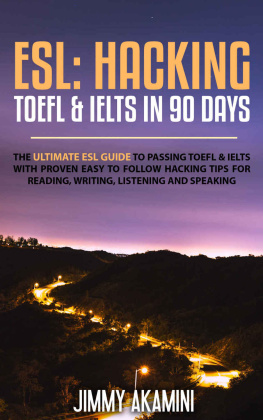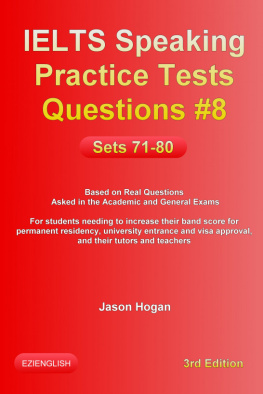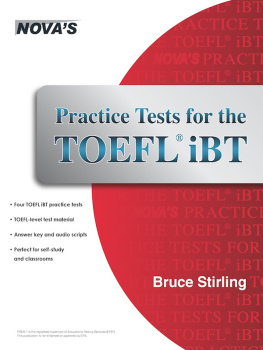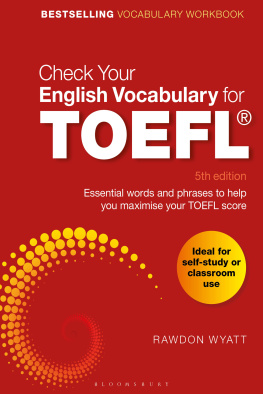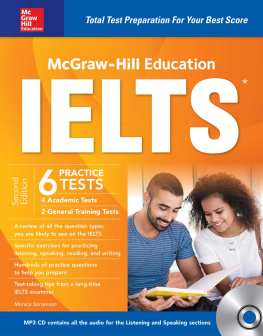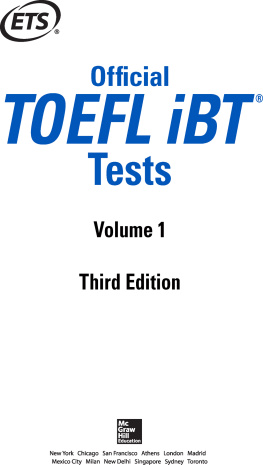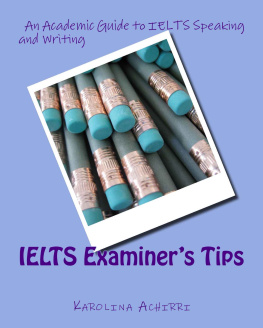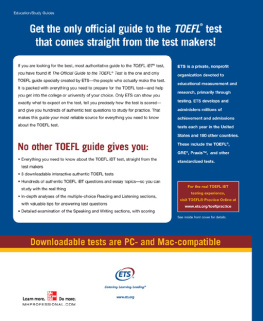ESL: HACKING TOEFL & IELTS IN 90 DAYS

The Ultimate Guide to passing TOEFL & IELTS with proven hacking tips on reading, writing, listening and speaking
2016 Tenlavi
All rights reserved.
All rights reserved. No part of this publication may be reproduced, distributed or transmitted in any form or by any means, including photocopying, recording or other electronic or mechanical methods, without prior written permission of the publisher, except in the case of brief quotations embodied in critical reviews and certain other noncommercial uses permitted by copyright law.
The use of trademarks is not an official consent by the trademark owner for the re-use of the eBook or brand. All trademarks and brands in this book are for clarifying purposes only and are owned by respective owners

Introduction
I want to thank and congratulate you for downloading the book, ESL: Hacking TOEFL and IELTS in 90 days.
Are you a non-native English speaker embarking on an English journey? Have you been preparing for your TOEFL and IELTS and plan to take the exams soon? Then this book is for you. This book contains proven steps and strategies on how to pass TOEFL and IELTS at your convenience in 90 days. I will take you through the basics of preparing for the exams, the tricks you need to learn and the practical guide and exercise for each module of the exams. This book is written in such a way that if you understand the book in its entirety, you are ready to take your exams.
Thank you again for downloading this book, I hope you enjoy it as much as I have enjoyed compiling it!

TABLE OF CONTENTS
INTRODUCTION
CHAPTER 1: Getting started
CHAPTER 2: Starting early, finishing strong
CHAPTER 3: Reading
CHAPTER 4: Listening
CHAPTER 5: Speaking
CHAPTER 6: Writing
CHAPTER 7: Schedule planning
CHAPTER 8: The final week
Supplement A: Additional online course
Supplement B: Checklist
CONCLUSION

Chapter 1: Getting Started
1.1 Why TOEFL or IELTS?
English is today the most widely spoken language in the world. It is the language of commerce and knowledge. Most employers today demand a minimum degree of familiarity with English because of our global community. Furthermore, world-renowned educational institutions also demand some degree of English familiarity from its staff and students. English-language skills are also part of the requirements of immigration and residences in many countries.
Various standardized English-language tests like TOEFL and IELTS give aspirants a chance to demonstrate their proficiency in the language. The Test of English as a Foreign Language (TOEFL), conducted by the Educational Testing Service (ETS) is accepted by some 8,500 colleges and universities in 130 countries around the world. The International English Language Testing System (IELTS) is conducted jointly by British Council, IDP: IELTS Australia and Cambridge English Language Assessment. This test also has wide acceptance and is recognized by over 9,000 organizations in 130 countries around the world.
1.2 Real-world English
TOEFL and IELTS are a little different from the English exams we took in school. Both TOEFL and IELTS test your language skills in four areasspeaking, listening, reading, and writing. But they do this in integrated tasks which is a combination of all the different skills within a test question. For instance, some test questions will require you to read, listen and then speak in response to a question, while in others you will have to read, listen and then write your answers. In TOEFL and IELTS the focus is more about applying your knowledge of the language in concrete, real-life situations. They want to know if you will be able to understand what is being taught in a classroom, complete your academic requirements, and have a friendly social life with people during your stay in the country. So, the main thing is they are not looking for textbook knowledge of the English language. The ultimate purpose of both the tests is the same, your functional ability to understand and communicate in English in its oral (speaking and listening) and written (reading and writing) forms.
This also means that you can prepare for both the tests in much the same way. By studying smartly, you can easily make up for the minor differences between these two tests.
1.3 Some TOEFL and IELTS Basics
For first-time test-takers, the decision to take the test brings with it many overwhelming questions: How and where can I take TOEFL or IELTS? What questions will they ask? How do I use the marks for my college admissions or immigration application? This section will help you with the registration and testing procedure for these tests.
1.3.1 Registration
Both IELTS and TOEFL can be taken at over 9,000 centers across the world.
You should note this major difference
(a) TOEFL can be taken in paper-based or computer-based format;
(b) IELTS can only be taken in written form.
IELTS allows you the option to choose between the Academic and General Training optionschoose the former if you are applying for higher education and the later if it is for employment or immigration purposes. But there is only one TOEFL test, which tests the ability to communicate in academic settings.
The easiest way to register for these two tests is to do it online. The details for TOEFL registration are provided at www.ets.org/toefl while those taking IELTS can visit www.ielts.org . These websites will tell you everything you need to know about registration, fees, required documents, test centers and test dates in your country.
TOEFL and IELTS are held almost four times a month, which gives test-takers a lot of flexibility in their preparation schedule. But do remember that both tests need you to register at least seven days before the date of the test.
1.3.2 Test Format
Both TOEFL and IELTS are divided into four sectionsspeaking, listening, reading and writing. But as stated earlier, their test formats are slightly different.
TOEFL must be given in a single sitting. It takes about four hours to complete the test. The first section is Reading (60-80 minutes), followed by Listening (60-90 minutes), then Speaking (20 minutes) and finally, Writing (50 minutes). A compulsory 10-minute break must be taken after the Listening section. You cannot go back to a section after you have completed it, except in the Reading section where you can return to previous questions within the time allotted. Each section is allocated 30 marks, and the final mark is out of 120.
The IELTS format is a little more complicated. The Listening, Reading and Writing tests must be completed on the same day, one after the other, without any breaks in between. The Speaking test may be scheduled on a different day from the others. The Listening and Speaking sections are the same for both the Academic and General Training papers, but the Reading and Writing sections are different. The whole test takes approximately 2 hours 45 minutes to complete. Marks for each section are marked on a band between 1 to 9, and the overall mark is an average across the four skills.
Mark reports are sent by mail to candidates soon after the test. Both tests also allow candidates to have their marks sent automatically to a small number of institutions free of chargeTOEFL can send the candidates marks to four institutions while IELTS can send the results to five institutions. The marks for both tests are valid for two years.
Next page
